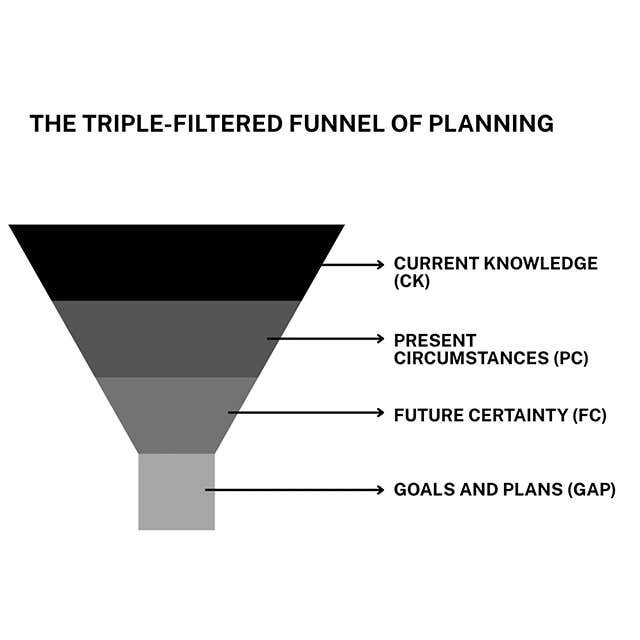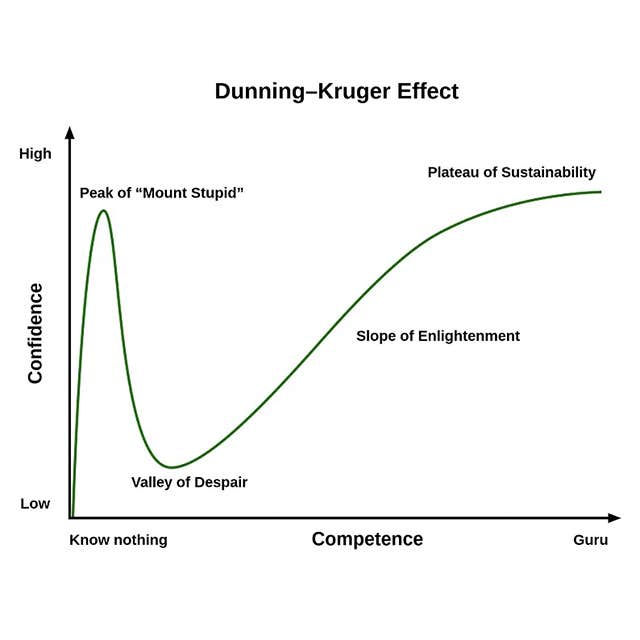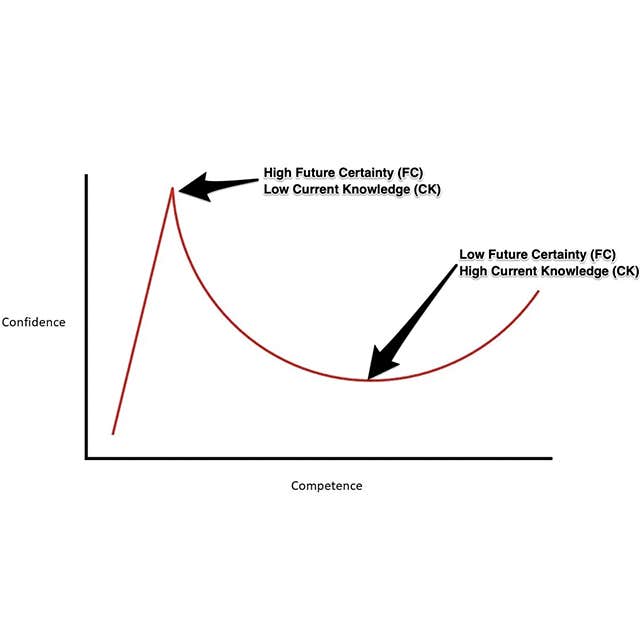The Most Undervalued Life Skill, According To CEOs
A comprehensive guide to the skill that helped YouTube, Wrigley, Nintendo, and Airbnb become billion-dollar behemoths.
 PeopleImages.com - Yuri A / Shutterstock
PeopleImages.com - Yuri A / Shutterstock "Tune In, Hook Up."
Sounds like a scammy "Meet single women nearby" website scheming to steal your credit card info?
It was the 2005 slogan of YouTube — a video-dating site that kicked off on Valentine’s Day.
Few tuned in. Fewer hooked up. So, for kicks and giggles, the co-founder Jawed Karim posted a zoo video gushing over the "really, really, really, long trunks" of elephants.
This triggered a trickle, then a flurry, of funny, then funnier videos by other uploaders.
Google noticed and swooped up YouTube for $1.65 billion — today, YouTube is a 100x behemoth with 2.1 billion active users.
YouTube isn’t the only company to grow exponentially after "pivoting."
Airbnb started off leasing mattresses. Instagram was a local catchup app. Starbucks initially sold coffee beans and machines. Twitter began as a Podcasting platform. Wrigley pivoted twice — from soaps to baking powder to chewing gum.
The $52-billion gaming colossus Nintendo? A pivot-filled struggle — from playing cards, it experimented with taxis, hotels, TV, food, toys, and more.
While companies that pivoted (as necessary) created history, ones that didn’t became history.
Recall Polaroid cameras? How about Kodak films? The sturdy Nokia 3310? Yahoo answers? The slick Blackberries we thumbed away on? Sony Walkmans?
Through the rise and fall of corporations, timely pivoting has stood strong as a harbinger of success.
But pivoting is equally, if not more, crucial in our human lives — because what’s true for a company of people is often truer for the individual.
"If you do not change direction, you may end up where you are heading." — Lao Tzu
And in today’s shape-shifting maze of a world, our initial "correct" direction might lead us to a dark dead-end.
Problems with rigid long-term "goals" & "planning"
If a goal is a future point we (think we) want to reach — planning is the map, and execution is the climb.
If our goals are 100% specific and planning is 100% perfect, execution becomes a simple button press.
So, our Goals and Planning (GAP) are the real determinants here. They stem from 3 factors:
- Our Current Knowledge (CK) — Our self-awareness, beliefs, desires, and information about the external world.
- Our Present Circumstances (PC) — Our health, workplace/college, relationships, family, residential city, debt, assets, and peer group.
- Our Future Certainty (FC) — Our sense of where our life’s going, where it should go, and conviction in it.
Our long-term GAP is a consequence of our CK, molded by our PC, and constrained by our FC.

But this funnel is an impossible Utopia — CK, PC, and FC can never align perfectly.
Here are 4 problems with rigid long-term goals and planning:
1. The Dunning Kruger conundrum
The Dunning-Kruger effect states "The less we know, the more we think we know."
The flip side? As Aristotle said, "The more you know, the more you realize you don’t know"


This makes CK and FC inversely proportional — the more knowledge we gain, the less certain we grow. And vice versa.
- Low CK? Then, High FC — Our vigorous planning suffocates us — like my pristine 2023 plan, now in the trash bin.
- High CK? Then, Low FC — Paralyzed by the awareness of the massive unknown, rigid GAP feels impossible. Finding conviction becomes a challenge.
Low CK about digital photography + High FC in its brand is why Kodak failed — while High CK + Low FC is why Nintendo’s marching with unparalleled innovation.
2. The core of our CK Is (mostly) a black box
Higher self-awareness = Clearer beliefs and desires = Better understanding of the external world.
But married to our smartphones, hooked to Instagram, and addicted to status signaling, we’re self-unaware.
Our beliefs? What our parents, schools, and pop media have programmed us to believe.
Our desires? What our consumerist society, social media influencers, and million-dollar ad campaigns want us to desire.
"We buy things we don’t need with money we don’t have to impress people we don’t like." — Dave Ramsey
Just a year ago, I was a red-pill Casanova "wanting" to build a men’s lifestyle business, become a millionaire, serial-date women and flex it all online.
But my spiritual awakening made me realize:

Discovering what we want = Discarding what society wants us to want — a long journey of epiphanies, identity crises, and clarity.
"Sometimes the longest and hardest journey we must undertake is the one that leads us back to ourselves." — Jack Canfield, The Key to Living the Law of Attraction
This slow unveiling of our true desires is why our CK can never suffice for rigid GAPs.
3. PCs change (beyond our wildest beliefs)
Amidst a hot fling, I lost my grandfather — my father figure and our family’s backbone. Losing faith in determinism, I went through a mental crisis.
A year later, hyper-driven in strict monk mode, my girlfriend thundered into my life — rewired my "red pill" beliefs, plunged me into spirituality, and helped me find God.
Present Circumstances (PC) ≠ Future Circumstances (FC).
Life swerves 360 degrees — often when we least expect it to.
Then, our long-term GAPs spin on their heels like ballerinas on Adderall.
4. The greatest problem of them all
Our Current Knowledge (CK) is 0.0000000000000001% of Total Knowledge.
Fed by 5 sense organs, the 6-inch fleshy mass in our skull spits out our version of "reality" — an infinitesimally small subset of actual reality.
A flawed subset at that — thanks to our inattentional blindness, sense organ limitations, and mental biases.
When "unplanned" things happen, we stamp the labels "Serendipity" for good and "Ill Luck" for bad. Either way, it’s crucial to pivot:
- When my writing Gumroad store got suspended, I created a self-improvement one — thriving with 6000+ downloads, it also better aligns with my interests.
- When focused on the masculinity niche, my 2-minute journaling template blew up — so I pivoted my brand from masculinity to all-around self-improvement.
Top companies are masters at this — like Twitter pivoting from podcasting to microblogging, threatened by Apple’s iTunes. Or Netflix pivoting to streaming after Blockbuster laughed it off.
Phew! That was one long monologue to illustrate why rigid long-term planning fails — and why fluid planning with ample room for pivoting wins.
Not convinced yet? My curiosity’s burning to know your counter-argument(s).
Psychological hindrances to pivoting successfully
In a 1973 failed bank robbery, the assailant took 4 employees hostage.
Post-release, the ex-hostages sided with the captor, didn’t cooperate with the police, refused to testify against him in court, and even raised money to fund his defense!
Now known as Stockholm syndrome, this coping mechanism can turn stress and trauma into an emotional bond of familiarity.
Be it a toxic relationship, soul-sucking career, or abusive parents, Stockholm syndrome can keep us married (or oblivious) to enforced misery.
"People prefer the certainty of misery to the misery of uncertainty." — Virginia Satir
Stockholm isn’t alone — an even bigger mental trap is also at play.
It’s the sunk cost fallacy — our tendency to cling to sinking ships purely because of the past time/effort/money we’ve invested into it.
Pouring money into plummeting investments. Serial-visiting counselors to stitch back a torn marriage. Pushing past burnout to appease the same toxic boss.
At the core is our ego’s strong desire to be right. To not admit we’ve gone wrong.
This can trickle down to even tiny decisions. As Lina Patel says in Raise Your Innovation IQ, "If you’ve ever held on to a pair of shoes that make your feet ache or a pair of pants that no longer fit you for no other reason than you paid a lot of money for them, you’ve experienced the sunk-cost bias."
How do you know when it's time to pivot?
In a society that worships "stability," and "comfort," — pivoting has a negative connotation.
Add the 2 Ss (Stockholm and Sunk-cost), and the resistance to pivoting is absolute.
That’s why this article’s long introduction and the much longer "Problems with Long-term GAP" section exist.
Only if you internalize the necessity and power of pivoting will you (choose to) recognize the pivoting signs and act on them.
These signs depend on the 3 factors of Goals And Planning (GAP) — here’s a quick refresher:
- Our Current Knowledge (CK) — Our self-awareness, beliefs, desires, and information about the external world.
- Our Present Circumstances (PC) — Our health, workplace/college, relationships, family, residential city, debt, assets, and peer group.
- Our Future Certainty (FC) — Our sense of where our life’s going, where it should go, and conviction in it.
With conviction and self-awareness, half the pivoting battle is done — the easier half is recognizing when to pivot. In my experience, there are 5 signs.
Here are 5 indicative signs that it’s time to pivot:
1. FC Oscillation — Moving back and forth Between "Yes" and "No"
Quitting my 9 to 5 was a year-long struggle — swinging from "Not that bad for the secure pay" on regular days to "Why am I doing this?" on 12 AM system failure days.
The occasional self-doubt and uncertainty are normal, but if doubt haunts you — for weeks, months, and years?
Pivot towards the side of higher uncertainty — since you can always return to the certain side if it proves wrong.
Within hours of breaking up with my girlfriend, I realized I had messed up big time. And made it back to her the next day. We're stronger than ever now.
2. CK Explosion — An epiphany or sign you can’t "unknow"
Two minutes of watching a lamb get slaughtered made me quit 20+ years of eating meat — despite witnessing plenty of fish-gutting, chicken-cutting, and goat-slaughtering growing up.
Sometimes, events + situation + mental state align perfectly in a burst of "realization."
Most of us ignore such epiphanies — but they’re powerful opportunities to pivot.
Don’t underestimate or ignore the power of CK Explosion — think and decide while the epiphany is raw in your mind.
3. Desire Decay — What used to enflame your soul no longer does
Fresh out of college, I enjoyed my software job — and my higher-ups saw "high promise" in me. But as my interest waned, my performance dwindled, and anxious stress set in.
One and a half years in, I dreaded even the easiest work and questioned the notion of a 9 to 5.
One day, in a CK explosion, clarity set in — and I put in my papers.
Often, a fountain of fresh zest leaps up when you pivot. Right after I quit, the stress, anxiety, uncertainty, and fear evaporated.
4. Deteriorating PC — You’re suffering and it doesn’t seem to reduce
When there’s internal suffering, external signs always crop up.
Before pulling the plug on my 9 to 5 job, my (mental) health had gone to the dogs — painful migraines, ugly NoFap relapses, irritability, and helpless melancholy.
Before I went monk mode and met the love of my life, serial dating played American football with my mental health.
Suffering is an inescapable part of life — but if it’s persistent, suffocating, and unending?
The universe’s likely nudging you to pivot.
5. FC+CK arising from the gut
With 500 million neurons, the gut’s almost a "second brain."
Though it can’t compose poems or solve calculus, our gut’s neurons can relay signs that the brain can’t — in tandem with the heart, which also has 40,000 neurons.
While our conscious brain is clear, and "logical," our subconscious possesses a vaguer but deeper intelligence — which can manifest in the gut and heart when the conscious hogs the brain.
While the science isn’t 100% clear yet, we’ve all experienced the gut instinct — a fresh stream of Future Certainty (FC) + Current Knowledge (CK) you can’t quite explain.
Call it intuition. Call it universe signs. Call it God’s whispering.
Our "inner voice" is often the ultimate truth — as a phrase we casually throw around goes, "When you know, you know.”
The hard part is distinguishing it from our own wishful delusion — that’s where meditation, journaling, talking to a trusted well-wisher, and prayer come in.
Here are 7 incorrect reasons often mistaken as pivot signs:
1. Finding something hard
Difficulty isn’t a reason to pivot.
The most rewarding things in life are difficult — working out, eating healthy, building a business, forging relationships, and staying consistent with them all.
2. Not giving it enough time
Every endeavor has a "suck" period you need to bear through.
Be it writing, coding, lifting weights, online business, or martial arts — pour in at least 6 months of dedicated effort before calling it quits.
3. Not finding the endeavor "exciting"
In our hyper-stimulated world of deep-fried dopamine receptors, we crave excitement. But a rewarding life is built upon boring consistency — waking up early, exercising, working, reading, investing, repeating.
As Jim Rohn said, "Success is nothing more than a few simple disciplines, practiced every day."
4. Because others are doing it
A pivot is most often when others are not doing it.
"Everyone" follows "everyone else." The "majority" are overweight, unhappy, live paycheck to paycheck, suffer from FOMO, and are lost.
"Don’t follow the majority. Follow the truth" — Imam Ali
5. Assuming the "grass is greener on the other side"
To those on the other side, your side’s greener.
Entrepreneurship or a 9 to 5. Kids or no kids. Relationship or single — they’re all choices with unique pros and cons.
See both sides and decide which green grass you prefer.
6. As it's the easier option
A pivot is never easy.
It broke my heart to break up with my girl. Quitting my job took gulping down my ego, fear, and uncertainty.
7. Because an online "guru" told you to
Most gurus tailor their advice to align with the course, ebook, or "mastermind" they’re selling.
Even 1-on-1 advice from someone you respect isn’t gospel — external advice can only guide your internal judgment. You must decide.
A powerful sign that you have pivoted correctly:
While working at my 9 to 5, anxious uncertainty and hyperbolic fears plagued my soul.
What if I got fired? What if my writing income dried up? What if my account got banned?
But the day I decided to quit, the mental turmoil vanished — when it should have spiked up by all logic!
Despite not having a solid future plan, my mind was at peace — the calm conviction of "I’ll figure things out" replaced the constant doubt of "Should I quit? Or continue?"
Stress-free conviction in the face of uncertainty is a sure sign of a correct pivot.
It’s subconscious FC — deep down, you know that you will soon know what you don’t know yet (but need to know).
"When you make a choice guided by the truth within your heart, your soul feels lighter, and you know it’s the right path." — Oprah Winfrey
One crucial thing most don't talk about pivoting:
Mistaking my egotistical biases and internal demons as "signs," I broke up with my girlfriend. Instead of relief and conviction, alarm washed over me.
Swallowing my ego and admitting that I was wrong, I got back with her the next morning — while it took weeks for the relationship to heal, it’s now stronger than ever.
There’s no way to be 100% sure about a pivot until you execute it. So, ensure your pivot’s reversible — with minimal cost.
- If it’s a breakup, be 100% vulnerable and honest — explain the true reasons and your internal struggle. Explore alternate solutions, if any. Own up to the decision and accept the repercussions.
- If you’re leaving a job to pursue your own thing — tie together loose ends, give credit and appreciation where due, drop personal notes to close colleagues and leave on amicable terms.
- If you’re pivoting your business, don’t wipe out the existing stuff — you never know what might come in handy. When my first Gumroad store was suspended, I preserved the main ebook — which many friends found useful.
It’s both stupid and arrogant to spew h***fire and burn bridges. You have nothing to lose by pivoting amicably — and everything to gain if it proves wrong.
Reversible pivots eliminate risk while letting you stir the pot of opportunities.
Pivoting, if you think about it, matches your plan with the universe's.
It’s like those childhood path-finding puzzles where we’d draw a line till an obstacle came up — and then, with no qualms, we’d pivot our path.
But as adulthood kicks in, life goes from a path-finding game to a sprint race. Let’s regain our childish glee and acceptance of change.
Let’s pivot when the right signs appear:
- Repeatedly oscillating to and fro for a decision — over weeks, months, and years.
- Sudden epiphanies and bursts of clarity — that we brush under the rug.
- Rapidly waning interest in something you initially enjoyed.
- Deteriorating health, joy, and motivation — in response to internal suffering.
- Your gut tugs at you — trust your intuition.
Plow through and don’t pivot at fake dead ends and illusory obstacles:
- The path seems difficult and "boring" — nothing rewarding comes easy.
- Seeing others pivot in a different direction —The Truth > The Majority.
- Assuming the grass is greener elsewhere — it’s green everywhere.
- Because pivoting seems easier — that’s just a cop-out.
- Because an online guru or mentor told you to — listen, weigh it in, but make your own decision.
Chew on the (real) signs. Meditate. Journal. Talk to a trusted well-wisher. Hug your mother.
Then, pivot — amicably, with minimal damage, and from a point of humility.
If the pivot proves wrong, pivot back — without shame, or feeling you’re "back to square one."
As Hermann Hesse wisely said in Siddhartha, "We are not going in circles. We are going upwards. The path is a spiral; we have already climbed many steps."
Neeramitra Reddy is a 12x Medium Top Writer, Chief Editor/Columnist for In Fitness And In Health (IFAIH), and a Columnist for Wholistique.

